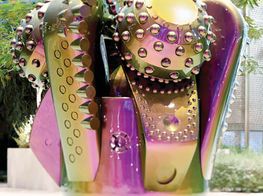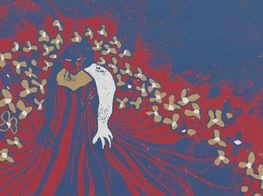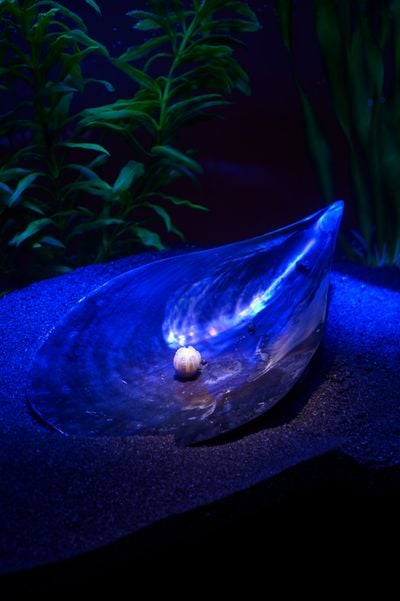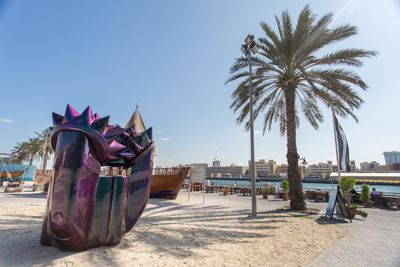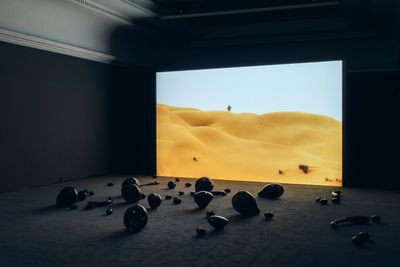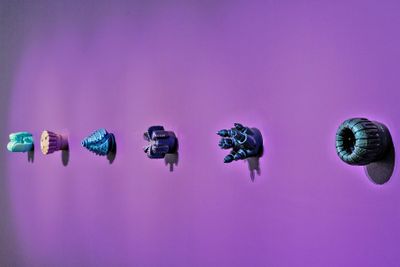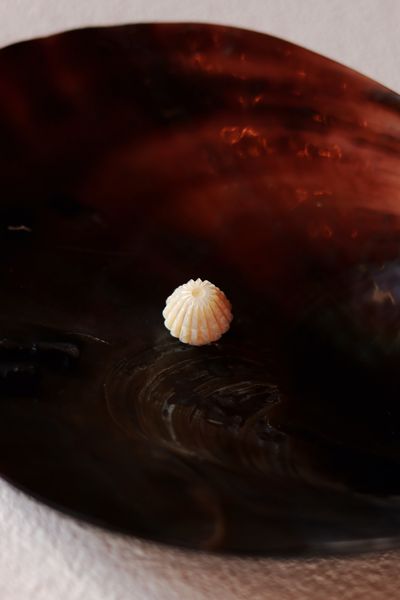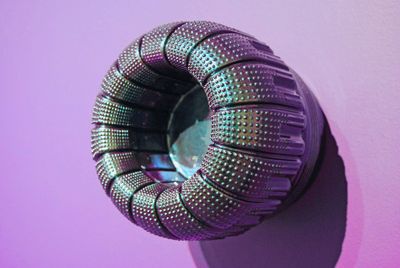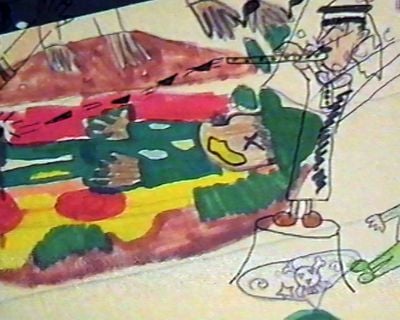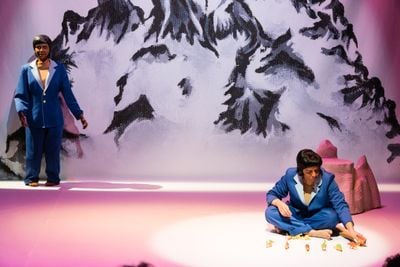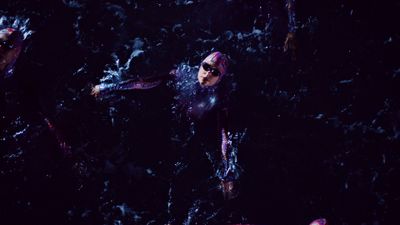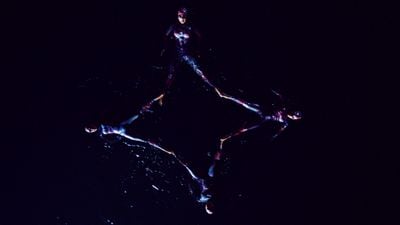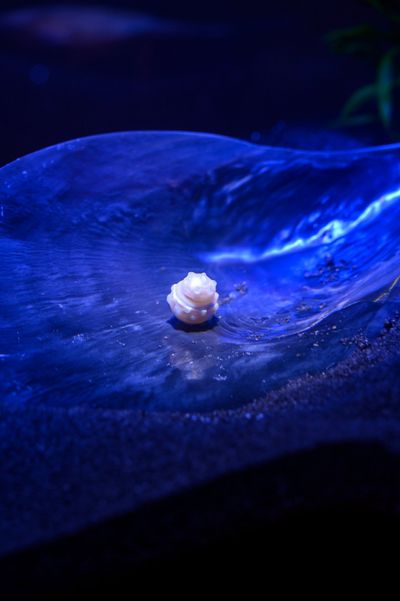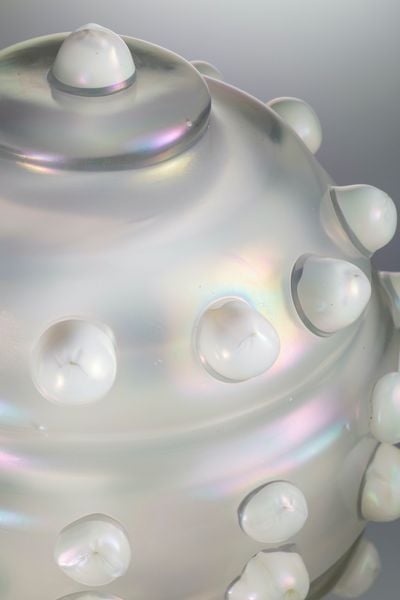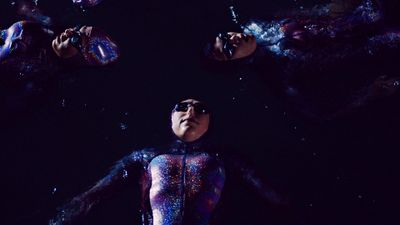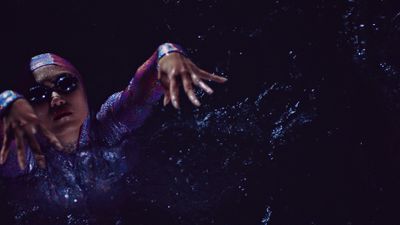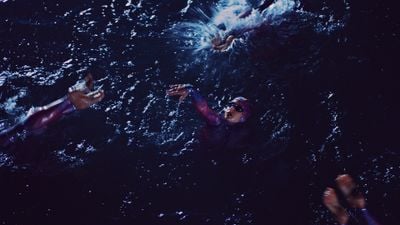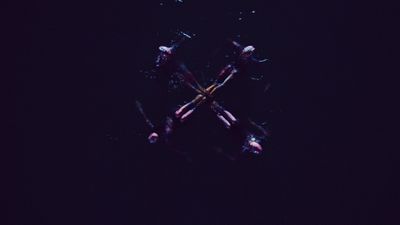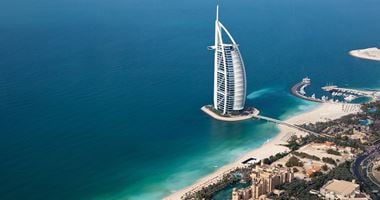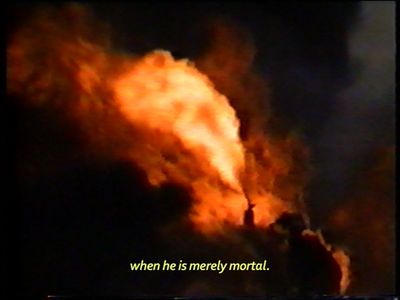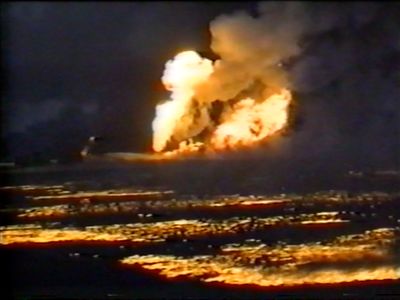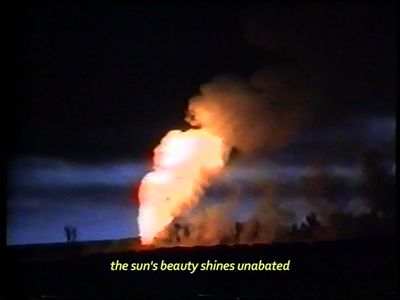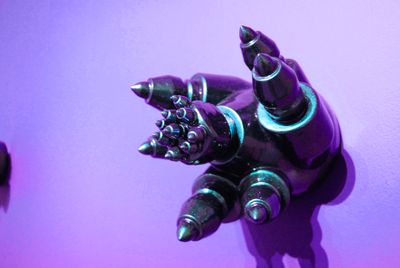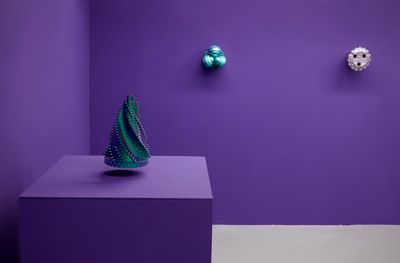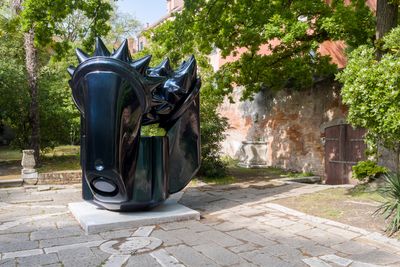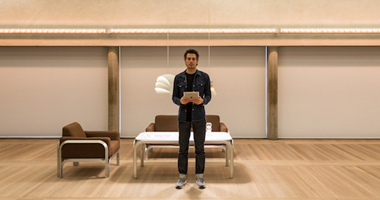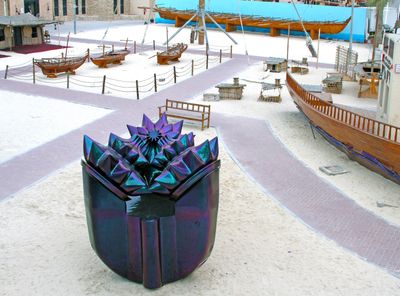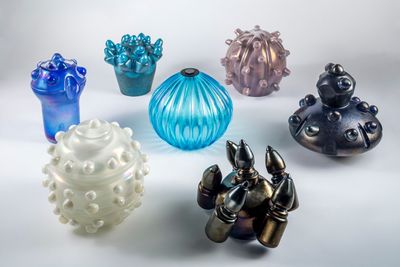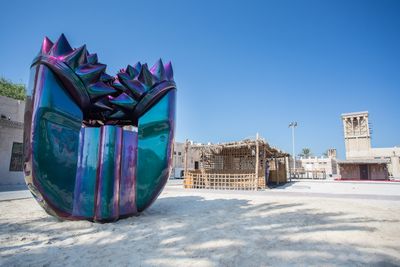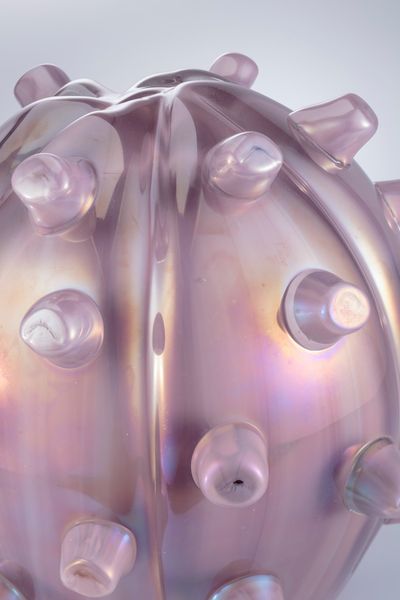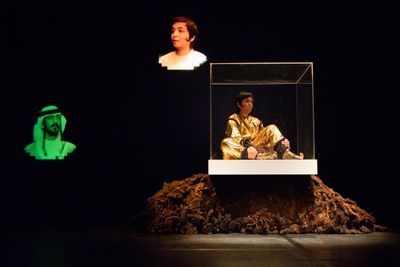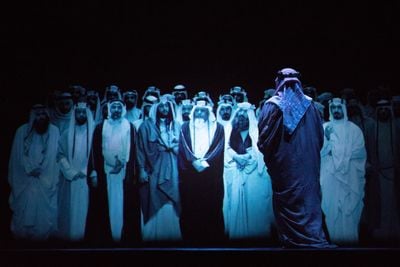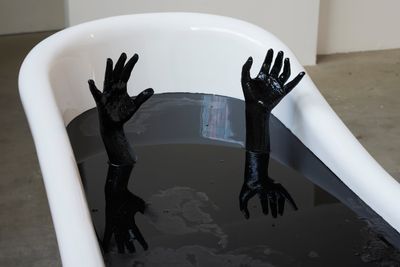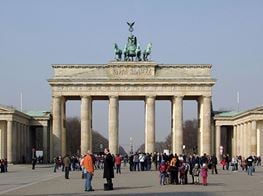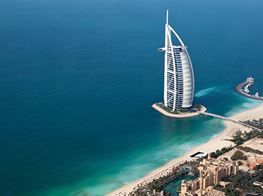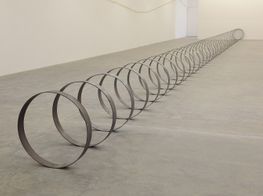Monira Al Qadiri Dives Deep Into Oil
In Partnership With The Art Gallery of Burlington
Courtesy the artist. Photo: Raisa Hagiu.
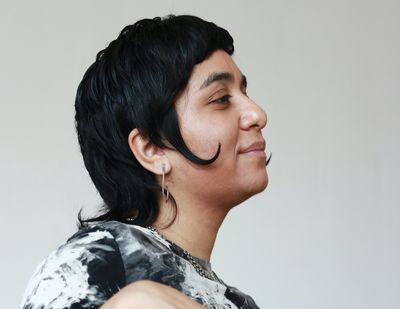
Courtesy the artist. Photo: Raisa Hagiu.
Monira Al Qadiri, a Kuwaiti artist living and working in Berlin, produces research-based work that focuses on the aesthetics of sadness in the Middle East, manifesting in poetry, music, art, and religious practices. Her practice explores unconventional gender identities and petrocultures and their possible futures, as well as the suppressed legacies of colonialism.
This spring, the Art Gallery of Burlington (AGB) opens the first Canadian solo exhibition of Al Qadiri with an immersive video installation, Diver (2018), curated by Suzanne Carte (1 March–31 May 2021). The work is part of the artist's ongoing search for historical ties between the pre- and post-oil worlds in Kuwait. It captures the movements of four synchronised swimmers in the night waters, possibly the Gulf, wearing iridescent head-to-toe bodysuits, goggles, and full makeup, and performing a choreographed routine to an early recording of a traditional pearl-diving song.
The weight and beauty of Diver provides an opening for audiences to contemplate their multilayered relationships to the transnational oil industry and fossil fuel consumption. Canada is a country founded on natural resources and bound in extractive capitalism, with the oil and gas sector being flashpoints for the federal government's struggle with the oppositional mandates of climate change mitigations, economic resolve, resource development, and reconciliation with Indigenous peoples.
While the work resonates within a Canadian context, the exhibition's intent is not to conflate the two different histories, or these different lands and people; instead, it means to provide an opportunity for discussion about the complexities of state-supported industries and socio-economic relations of the energy sector with Indigenous self-determination and ecological safeguarding.
Amin Alsaden, a Toronto-based curator and scholar, joined Al Qadiri on 6 February 2021 to discuss their common interests in the global impact of oil, from rapid modernisation and armed conflict, to the representations of Arab oil-producing countries.
This transcript is an edited version of their conversation, which took place online. The discussion underlines the manner in which the artist's practice reveals complex intersections between a global dependence on fossil fuels, the destruction of the environment and traditional ways of life, and the formation of modern individual and community identities.
AABefore we get into Diver, I believe a brief overview of your biography is important for understanding your practice. You were born in Dakar, Senegal, to Kuwaiti parents, one could say in a political and artistic family. Your mother is the great Thuraya Al-Baqsami, a pioneer of Kuwaiti modern art. So I imagine that you grew up breathing art.
MAQYes, basically I grew up inside my mother's studio. For me and my sisters, fooling around with paints and paper was a substitute for playing. It was our playtime. And my mother never actually taught us how to make art; she would just give us her materials and her studio and let us run amok in there.
So I never actually thought about being or doing anything else. I always want to acknowledge this generational quality of some artists, because sometimes people don't like to recognise that. It's very important to me that my mom was a female artist who started practicing in the sixties, and in Kuwait, that's very rare. Without that environment and that kind of encouragement and inspiration, I don't think I would be doing what I'm doing today.
AAAnd your father was a diplomat in Western Africa when you were born. Your family then returned to Kuwait, where you grew up. Kuwait is a relatively young country, having been founded only in 1961. What can you tell us about Kuwait, in terms of the rapid transformations that were taking place in the Gulf region?
MAQMy parents' generation experienced both worlds: the pre and post-oil world, which was dirt roads and mud houses in the 1950s, and then suddenly this oil alien landed. I like to call it an 'alien' because it really felt that way.
Then the nation was founded and everything changed. I think the sixties and seventies in Kuwait was a period of optimism and futurama, when everything suddenly seemed possible, and it became an extremely liberal place. It was the golden age of Kuwait.
I didn't experience that transformation. They moved back in 1983, a few months after I was born. The eighties was also an interesting, very strange, polarised time, where suddenly there was this wave of religious conservatism overtaking the country. There was the war between Iraq and Iran, which also really polarised a lot of people, because Kuwait is a very mixed bowl. Sometimes I call it a mini America. There are people from everywhere, ethnically speaking. It was a port town.
After the war in 1991, that's where my period of consciousness as a person and as an artist came to be, which was a time of political and social paralysis in the country.
AASo you were born after the oil boom, but it was your parents' generation that experienced both eras.
MAQYes. I call myself a post-oil baby. I only know the glitzy, fancy, futuristic Kuwait. I don't know the old Kuwait. It's always advertised to us as our history and heritage, but I never thought it was part of my life. It was always this foreign, exotic, strange, fictional place.
AAA pre-history, in a way, with oil being the starting point of everything.
MAQYes, exactly.
AAAnd then, there was this important event in your early childhood that consolidated your interest in art-making and started a long and critical engagement with some of the main questions you have been pursuing in your work. This event was the 1990 Iraqi invasion of Kuwait, and the Gulf War that ensued. Tell us about that experience and how you and your family responded to this crisis. Your family did not choose to escape Kuwait at the time, like many others did.
MAQMy dad said we had to stay, so we stayed. Both my parents really love their country. I was seven years old and my sister Fatima Al Qadiri, who is a well-known musician now, was nine.
As a child, you don't really have a clear sense of morality. You can't fully understand the world around you. Your vision of life is quite limited. So for us in the beginning, it was really almost fun. There was no school, so we just got to stay at home.
Obviously my parents did a very good job of shielding us from the realities around us. My mom just let us stay in her studio the whole time, giving us bounties of her art materials. I think we were just very creative with that time. It just felt like a giant video game for me, as if we were the good guys, and those were the bad guys.
I had a very simplistic worldview, whereas my older sister, who was 15 at the time, is still very traumatised. It's one of the darkest periods of her life. I had a completely different experience just because of my age. It's interesting how you always think children in war zones are having the worst time, but actually, depending on the situation, people who understand what's happening are suffering a lot more.
AAYou did experience hardship. You shared with me, for example, how there were food shortages, and how your father was taken prisoner.
MAQYes that's true. My family thought I couldn't handle the news that my father was taken as a prisoner of war, so they lied to me. They told me he had gone to Europe for a work trip. I was the only one who didn't know what happened. So when he came back, everybody was in tears and crying except me. I was like, 'Oh, Daddy's back from Europe.' It's strange how people shield you and protect you in this way.
I think that, in the Gulf especially, we're in this endless loop of knowing the reality of oil and that it's not going to last, but that the wealth it brings is always feeding this illusion of being grand and important and powerful.
At the same time, me and my sister were always making these very violent drawings of soldiers and us winning against the enemy. My mother also thought that that would really get us in trouble if somebody saw them, because inspections of people in their homes took place regularly. The soldiers would come in and check houses for weapons, hiding resistance fighters and the like. So she hid all our drawings in the AC unit. We actually still have those drawings. They're very sweet.
AAAnd because you spent so much time in another lockdown of sorts, not unlike the lockdown imposed on most of us these days, you ended up watching a lot of Japanese animations, which developed this passion for Japan. You decided to go to Japan to pursue an art education. What did you do there, and did you experience some kind of culture shock?
MAQYes. I used to watch these Japanese cartoons dubbed in Arabic. There were tapes of them at our house and I started getting obsessed with them during the war, I think to also escape what was happening.
I decided at that moment that I was going to go to this place. I just imagined that that cartoon was real and that somewhere that world, that life, existed. So in my naivety, I started teaching myself Japanese and became immersed in the culture, and I got a scholarship to study there when I was 16. So I went there by myself in 1999.
Obviously it was very disappointing, because the world was not a cartoon. I immediately became disinterested in cartoons. I discovered later that maybe it wasn't the cartoons that were really influencing me more than the Arabic voice acting. That's another project that I worked on later, called Feeling Dubbing. It's a theatre piece.
Japan was very interesting. For ten years, I really forced myself to be in love with it. But after ten years you also start to see the dark underbelly of Japanese society, and the hyper-capitalist culture that exists. That was very harsh.
Even though I come from an undemocratic monarchy, I felt that there's better social mobility in Kuwait, where you're guaranteed healthcare and school. In Japan there was this very cruel reality of total submission to corporate life, and if you exist outside of it, you cannot really be accepted by society, unless you are extremely successful. Especially for young, budding artists, it was a difficult place to be, so I decided to leave and came back to Kuwait in 2010, right before the Arab Spring.
AAI think we are ready to jump into Diver, your work at the AGB. How would you describe it, and what compelled you to produce this film?
MAQWhen I came back to Kuwait after Japan, I already felt very much like an alien. I don't belong in Japan and I don't belong in Kuwait. I don't belong anywhere, actually. I'm this mutant, I call myself.
So I wanted to start trying to find ways to connect myself to my ancestors, because in Japan that's very important. There's almost a cult of ancestor worship going on there. In the Arab world, that concept really didn't exist. I started thinking about it a lot. Who is my grandfather? Who is my great-grandfather? Those kinds of questions emerged.
My grandfather, who is my father's father, Issa Al Qadiri, was a singer on a pearl-diving boat. For me, growing up, I heard all of these stories about this man who would go out to the sea for six months and sing this labour music for the divers. He would have to sing and entertain them so they could keep going, because it was very difficult work.
For me, all of these stories just felt like fiction that somebody had made up, somehow. It was so detached from my life. So I started to try to find radical ways, even aesthetic and formal ways, to connect myself to him. He died before I was born, so I've never interacted with him.
AASo this is part of a long engagement—your search for links between the two eras bifurcated by oil discovery and production. The protagonist, your grandfather the diver, perfectly captures the pre-oil era, and it is through him that you establish a personal connection with that time.
MAQI started thinking deeply about these subjects, and the only thing I could find that I thought really formally connected me to him was the colour of pearls. I discovered that the colour of pearls is almost the same as the spectre of the colour of oil. It's on lighter and darker sides of the spectrum. It's called dichroic colour—it's this iridescent, rainbow-like colour. It was kind of an epiphany, that this colour is the colour of this ruptured history, and that maybe after the age of oil, this colour will live on in another form.
So I started making a lot of works around this idea. Diver was the culmination of this research. It's a work that I tried to make for almost seven years, but nobody understood what I really wanted to do. I just imagined the scene of synchronised swimming in the ocean at night so that the water would look like oil, and that these swimmers would be dressed in dichroic colour bodysuits and they would be choreographed to the songs of the pearl divers.
The recording is actually one from the early 1960s, so it's very close to the real ones. It's very guttural. There's a lot of screaming. It's very different to the pearl-diving songs that are recreated now. Visually, it's a completely artificial scene.
I wanted to show how our collective ways of accessing history are always artificial. There's this laborious effort made to try and recreate it. Then it ends up being always wrong, but in a way it's beautiful that you try to attempt to relive it. So there's also this beautiful aesthetic quality to the video.
AAThe fact that there is no visual reference to him in the work is bizarrely appropriate, because it interrogates this question of visibility, which is also critical to how we understand or write histories, specifically about the pearl-diving vis-à-vis oil eras. There is a special place in the history of the Gulf for divers like your grandfather and for the pearl-diving industry more generally. Where does that come from?
MAQYes, I forgot to mention that before oil, the main industry in the coastal Gulf was pearl-diving. There are historic records that suggest it was going on for almost 2,000 years, and then suddenly this magic potion called oil comes in and the whole industry disappears, because people saw it as being completely unnecessary.
Oil is a curse and also a miracle.
The pearl divers didn't need to suffer for months in the ocean and risk death and disease for very little income when they could get a nice job, since the state has oil wealth now. It just naturally disappeared, and very quickly also.
The images of pearl-diving and boats and the music is always promoted in a way that they represent our history and identity. But then our lives in this oil economy are completely and utterly detached from that world. So there is this kind of cognitive dissonance there about self-identity. In this work, I also wanted to play a lot on the idea of gender, because the world of pearl-diving is male-dominated.
AAAnd yet you chose a sport—synchronised swimming—that is traditionally associated with women.
MAQYes, exactly.
AAThe notion of dissonance is key here, between the swimmers trying to synchronise their movements with the background song, the voices of men—but in some instances they actually do not. I found that quite telling.
MAQI come from a very patriarchal society. When me and my sisters and my mom were stuck at home and my dad was out performing heroic acts during the war, I encountered this strange moment when I thought, 'In order to be someone powerful in this society, you actually have to be a man.' So I started cutting my hair very short and cross-dressing.
It was really about power. It wasn't really about my sexuality or anything, because I was in love with men so much and I adored them to a point that I wanted to be like them. This obsession with my male ancestor comes from this fixation on men and the power that men have.
AASo there is a gender dimension that you are trying to highlight in this work, conveying the idea that gender is a social construct.
MAQYes, exactly. In this video and many other previous works, I always try to problematise this gender question in a way that it's always misplaced. The genders are somehow wrong, they're mismatching, but in a way they work quite naturally.
So I make these music videos where I play the role of a male singer of these very old folk songs and everything is wrong—the costumes are wrong, the makeup is wrong, the beard looks fake. Everything is kind of fake and mismatching and not in the right place. But it works and it gives this kind of beautiful mutant image.
This is also what I tried to do with this work. Synchronised swimming is a very strange water ballet sport that started in the late 19th century, early 20th century, as an all-female sport. There is no place for males in that space. There is something very bizarre about it as well.
I wanted to mould these things together and see how they fit, and they don't fit, obviously, but once you forget about those realities and leave your misconceptions behind, you can accept this image as working. I wanted to highlight the artificiality of the swimming with this very guttural, visceral sound from the song.
AAI am curious: how were those previous performances and films, where there was a bit of cross-dressing and you inhabiting these historic Arab male characters, received in the region? Were people engaged, amused, offended?
MAQThe first time I started showing these works, I was really worried that I might get in trouble because they touched on a lot of different taboos. But when I screened the first film, Wa Waila (Oh Torment), in Dubai in 2008, the cinema erupted with laughter.
I was so shocked because I really wanted to create this tragic image, and everybody just assumed it was comedy. And because it's comedy, everything is accepted. From that moment on, I started understanding that this kind of humour could be also weaponised. All of these things we're not supposed to mention and talk about, if somebody thinks it's funny, it's fine.
But afterwards, of course, my work has been censored many times. Sometimes for completely arbitrary reasons that have nothing to do with the work. But I don't find it strange. I think it's interesting, because I think censorship sometimes has to be really creative also. It's almost like this conspiratorial mentality where you're imagining this work is about this particular subject in your mind. So I find it amusing. It doesn't bother me.
AAIn addition to questions of autobiography and gender, oil is quite central to Diver. As you know, I am originally from Iraq, and you are from Kuwait—two countries that were in an unfortunate and unnecessary conflict. Yet we somehow bonded over a memory we both had as children, after the Iraqi army burned hundreds of Kuwaiti oil fields, which was certainly an environmental disaster, one of the largest in recent times. We experienced that event in very different ways as children, but we were somehow amazed by what we might call its sublime atmospheric qualities.
I think it is important to highlight that you as a child did not necessarily experience the war as a terrifying event. You did not see those clouds as something ominous or menacing.
MAQYes. I thought that we were living in this kind of version of hell that is written about in the Qur'an. I thought it was really magical. There were black clouds and black rain and our house was black. Obviously I didn't understand anything about the toxicity of these things, so I just thought it was really amazing.
Also, looking at this burning oil was the first time I actually saw oil and had a confrontation with it as a material substance. Until then, especially in the lives of people in the region, in the Gulf especially, the oil industry and the inner workings and the fragile nature of it was concealed from the public. It wasn't seen as a central tenet of their lives.
Somehow it's seen as this metaphysical, magic potion that exists in the background and that God bestowed on us to make everybody wealthy. It was a very strange moment when it revealed itself to us as a substance coming out of the earth.
AAThese memories and your multi-dimensional understanding of the war were crucial for an early film you produced, Behind the Sun, which was a critical response to another filmmaker's take on these events.
MAQYes, the first work I made about the subject in 2013 was a video called Behind the Sun, which was based on Werner Herzog's Lessons of Darkness (1992). Werner Herzog came to Kuwait after the war and he made a docufiction film where he was basically filming burning oil fields from a helicopter and reading biblical texts about the apocalypse and Armageddon and there was even a Wagner soundtrack in the background. I don't know where my parents got this VHS tape.
I just put it on and watched it, and as a kid, I was so angry and offended by this German man making up stories about 'our' war. I just couldn't accept it. I was so angry. Why would someone do this? Later and with time, I grew older and I went to art school and I understood Werner Herzog's work, what he was trying to do, but whenever I watch that film I go back to being that seven-year-old. I can't accept it.
AASo Behind the Sun was a critical response, or a rebuttal.
MAQYes. I wanted to reclaim the work and reclaim the context of the work, so I made this film about the burning oil fields, filmed by a photographer Adel Al Yousifi. He gave me these tapes he filmed from the time.
It was really eye-opening. It was a very shaky image of the burning oil filmed up close. It brought me back to that time where I had this sublime impression of it. Then I mixed that in with these Islamic poetry segments from TV. It just became this very strange work.
AAYou ended up showing it in Berlin? I really hope he saw it—I find it fascinating that these two works are now in dialogue with each other.
MAQYes, I showed it at the Berlinale in 2014. I was hoping he would be there.
AAIn Diver, the swimmers, thanks to the specific lighting effects you orchestrated, seem to be swimming in oil, or in water—because water is also where many offshore oil fields can be found. Are you saying that we are immersed, or maybe drowning in oil?
MAQYes. That's one of the ideas, but also the main idea about this work, and a lot of sculptural and video pieces and installations that I have done, is that I am preempting the end of oil.
The idea for this work actually comes from a practice in Azerbaijan of taking a bath in oil as a rejuvenating ritual that has existed for centuries, because before oil was used as fuel, it was used a lot for its anti-bacterial qualities.
Camels used to have oil put on their scars and things to kill germs. I thought maybe that oil, after it becomes obsolete as a fuel source or we run out of it, will go back to being this spa treatment material that people swim in in the future, and they have these suits that protect them from the toxicity of it. So it's also a science-fiction portrayal of the future.
In my other works, I make sculptures of oil drills that look almost like jewellery or octopuses. They look like marine creatures. They're really beautiful things.
As soon as you know that this is a fossil fuel that comes from a specific deposit in the earth's crust and that you have to drill and it's a really messy operation, then you suddenly also understand the fragility of it.
AAIn some of your sculptures, you make us see the otherworldly beauty of these oil excavation drilling bits, which look like aliens.
MAQYes. Also aliens. I paint them with these pearly, oily colours. I imagine also that in the future, nobody will know what these things are anymore, that it will become some relic from an older time and that people will start to imagine that maybe this was a crown used in a ritual of sorts. As soon as you remove it from that context, it becomes this beautiful object that's no longer a machine that destroys the earth.
AAYou had also mentioned to me how you discovered that these oil drilling bits are quite precious: they are encrusted with diamonds.
MAQYes, the diamonds and the gold are hard materials that help drilling, so the drills really end up resembling jewel-like objects. I was really shocked when I discovered them when I was doing research about my grandfather, and that as a Kuwaiti, I know nothing about them. Why had I never seen them? This was a very shocking discovery for me, because in reality this was such a central industry to our lives.
Kuwait is 90 percent dependent on oil, and we don't know anything about the mechanisms of its extraction. It was really a shocking moment for me. As soon as you know that this is a fossil fuel that comes from a specific deposit in the earth's crust and that you have to drill and it's a really messy operation, then you suddenly also understand the fragility of it. I think that's the main issue—that the powers-that-be don't want to show us how fragile and unsustainable this industry is.
AAI would argue that this is something unique to your work. I can think of several artists who have explored oil and its role in the region, such as Hajra Waheed, Ahmed Mater, Rayyane Tabet. Some have examined its history, and others have been critical of its detrimental impact, politically and environmentally, on the region and beyond.
But despite your criticism of the industry, you seem to think of oil as something that is integral to who you are, to your identity, and something that you cannot possibly escape, and should not deny.
MAQYes, exactly. Oil is a curse and also a miracle. I mean, it's a strange material. That's why I call it an alien, because it's inside everything. It's not just fuel. It's the petrochemical industry, which creates plastics and we couldn't even perform a single surgical operation without hundreds of plastic objects. It's even inside our bodies.
Also, as a Kuwaiti, I just feel like it's part of who I am. Oil has created this freak generation that's not going to last very long, this post-oil generation. I feel like it's part of my blood.
Actually the second work about oil that I made, Alien Technology, was this giant public sculpture of an oil drill in Dubai, placed next to pearl-diving boats. It's in a heritage village and the pearl-diving boats are actually these fake ones made for touristic consumption. So I made this public sculpture of a drill there. I felt that the drill was a self-portrait. It's a representation of who I am, placed next to the boat, which is my grandfather.
AABut you have also turned these oil drilling bits into architectural fragments, or monuments. They come across as remnants, or ruins from another era.
MAQI'm trying to look at them from a perspective in the future, when they're not used in this destructive way and they're just disused trash of the past. But I'm beautifying them with these colours to make them alluring and seductive, in a way that oil wealth is also alluring and seductive.
It's very tempting, even if you're told that this is an environmentally destructive and harmful substance, people are always seduced by the wealth that it can bring.
I think that, in the Gulf especially, we're in this endless loop of knowing the reality of oil and that it's not going to last, but that the wealth it brings is always feeding this illusion of being grand and important and powerful. It's an endless cycle of being seduced by wealth and greatness and what wealth can bring. It's really like the Tower of Babel. If you get too high up, you'll be struck down. I'm always trying to preempt that, because not a lot of people are talking about it.
Now, the discussion has changed a little bit because the price of oil has collapsed since 2014 and it hasn't really gone back up yet, especially now with the pandemic, it's really hit rock bottom. I'm glad this is happening. This had to happen someday, in order to stop all the conflicts associated with the substance as well.
I always imagine it's like the monolith in the beginning of 2001: A Space Odyssey (1968). It just landed there and then you touched it and your body changed, but then, like an alien, it will also leave again and your body will go back to where it was.
AAThe question of history is also central to Diver. I see you complicating our acceptance of national narratives, focusing as they do on the favourable aspects of modernisation, and how they valorise oil as the source of prosperity that transformed lives in the Gulf for the better. But you seem to be saying there are other histories that are not being acknowledged.
MAQYes. I'm very obsessed with history, especially since 2011. It's been a decade since the Arab Spring, and I was very involved in it. I just think that we are somehow lost in that area of the world, the Arab world, because a large segment of history is concealed from us, especially modern history, by undemocratic regimes.
Because you do not know your history, you feel lost, in a way. You cannot see the future if you do not know the past. So my work is always trying to address this hole in history. It's just difficult not to be able to delve into certain narratives that created this place and you as a person as well.
AAI am not talking here only about the history of the romanticised pearl-diving industry and the pre-oil era. I am also alluding to the history of colonialism that we tend not to talk about in the region. If I understand correctly, it was through your research that you were able to forge a connection with your grandfather, but through colonial narratives.
MAQYes, exactly. It's really a shame that sometimes the only written documents of like, let's say, early 20th-century daily life in the Gulf come from colonial sources. Because a lot of the history in that area is oral history and orally narrated. But these documents, written casually in a diary or blog form about life at the time, are by British and European and Australian explorers who went to Yemen and Kuwait and Saudi Arabia and wrote about their daily comings and goings.
It's strange that those are the only documents that allow us to access certain parts of our history that we don't know anything about. I find it very tragic. I mean my work is a lot about the aesthetics of sadness, and this tragic element is a very important part of what I do. I also think of the drills as a very tragic subject. It's a portrait of myself as a machine. There's something very unsettling about that.
AAAs a historian myself, I feel that your work, specifically Diver, is a statement about the fluid nature of memories, because as historians, we talk about how memories are unstable, how they are dependent on those who carry them, as opposed to history, which can actually be equally fluid, but it is often presented as something a lot more authoritative or stable. Are you trying to write an alternative history of sorts?
MAQYes, of course. I have a theatre piece I made recently called Phantom Beard, in which I speak to the ghosts of my ancestors, who were killed in a massacre.
I met a ghost reader in Japan, and she told me that there are 40 men attached to my body as ghosts. They had a terrible life full of blood and they think that I'm the chief of the tribe and they want to enjoy life with me. So I made this theatre play where I would see them on stage, projected as videos, and I would speak to them. It's a work about creating alternative histories, rediscovering the past, and reliving tragedy.
AAFor those who might know very little about Kuwait, the Gulf region, or who might believe that their life is not affected by oil, because they do not live in those geographies, what do you want them to pay attention to when the exhibition opens?
MAQI think everyone living on planet earth today is affected by oil in some way or another. If you're not an oil-producing country, you're an oil-consuming country for sure. A huge part of society and the way it's built and the products that you use are oil-based. There are some small attempts to not use oil-based products, and I'm very happy people are becoming more aware and conscious of that, but on the larger scale of things, it's very much integral to who we are as people in the modern world.
We really have to think about it and consciously find ways to disassociate ourselves in a positive way, but also admitting that it's there is very important. For example in Canada, there is a lot of fossil fuel extraction going on right now. It's causing destruction and pollution and I know there's a big movement against it. I think it's happening everywhere.
I was very interested how these histories can intersect in this moment where this is going on in that place. It's a worldwide problem that we have to deal with.—[O]

